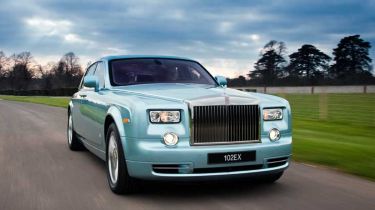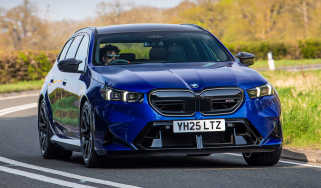Rolls Royce 102EX
It's the ultimate expression of the electric car – and we've driven it

It’s easy to knock this electric Roller as pie in the sky, but that’s the point of experimental cars. The battery pack almost recreates the Rolls-Royce wafting driving style and the silent driveline adds to the sybaritic appeal, but the cost, limited range and long recharging time, torpedo the practicality. Perhaps a range extender will be the ultimate answer. They’ll need to work on the steering, but the blue-lit Spirit of Ecstasy is a sure fire hit.
Find the idea of a family hatchback that plugs into the mains electricity supply a little hard to get used to? Then how about a 2.7-tonne limousine?
Meet the 102EX, Rolls-Royce’s latest experimental car, which swaps its BMW-derived V12 engine and six-speed automatic gearbox for a 640kg lithium-ion battery pack and two motors from the Tesla electric sports car. Engineered by Lotus Engineering, the Phantom is embarking on a year-long world tour and Auto Express grabbed a turn at the wheel before it left.
The 5.84-metre limousine nails its electric colours to the mast with its special iridescent turquoise paint, which uses nano-ceramic particles to give a lustrous shine. In the cabin, there’s an experimental leather floor and vegetable-dyed leather upholstery, which looks and feels lovely, but needs to be proven in the long term before it is adopted for production. To top things off, Charles Sykes’s Spirit of Ecstasy has been remade in plastic with an eerie blue light underneath.
Lift the bonnet and instead of oily mechanicals, there is a 96-cell advanced lithium-ion battery housed in five separate packs to make the maximum use of the engine bay. The motors are mounted above the rear axle, driving a conventional differential unit cleverly swung through 90 degrees. The raw figures don’t make promising reading, with the 71kWh battery giving a scant 124-mile range before needing a 24-hour recharge from a household supply. Top speed is limited to 100mph and the battery pack, with its theoretical life of three years costs by our estimate, over £100,000.
That’s the not-so good stuff, but on the plus side, the combination of battery and twin electric motors effectively replicates the power and torque output from the standard Phantom’s 6.75-litre 453bhp/720Nm V12, while adding just 200kg to the kerb weight.
Behind the wheel, the Rolls presents a subtly different face from the standard car, with the backgrounds to the instrument dials matching the exterior paint, while a battery-charge indicator replaces the fuel gauge and the infamous power reserve meter is adapted to indicate over-run recharging.
The starter button prepares the systems; moving the steering column gearchange quadrant into Drive gets the vehicle underway. Well it should, but the system has no creep built in, so the vehicle will roll backwards despite being in Drive. Once under way, however, the driveline is almost silent, although the big tyres make some contribution to the cabin ambience.
Performance is more than enough to spirit the 2.7-tonne saloon up the national limit, although in spite of the extra sound proofing used, the driveline whirrs audibly. Lifting off the throttle allows the big car to roll gently onwards, although the Low gear button on the steering wheel increases the recharging amps and slows progress rather more than you’d want.
Unfortunately we were quickly overtaken by range anxiety and with the battery reserve indicator heading south of a quarter charge, we headed back to Rolls' Goodwood factory. A 24-hour recharge off a domestic supply is clearly ludicrous, but Rolls-Royce is also debuting a wireless induction charging system, where the vehicle is parked over an induction pad, or three-phase recharging; both these alternatives can reduce recharging times to less than eight hours, which is still too high.
Despite Rolls-Royce’s hopes, you are always aware you are in something different from the standard V12 vehicle, which is so well engineered and refined it’s difficult to better. The 102EX’s steering isn’t as finely engineered and the power delivery isn’t quite as seamless and unburstable, but it is a fine achievement nevertheless. It’s the limitations of battery-electric technology rather than a fault with this Phantom's engineering that might relegate this experimental car to the museum of hopeful failures.







